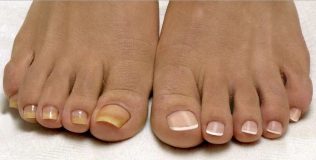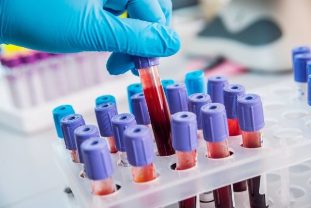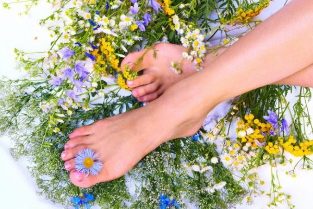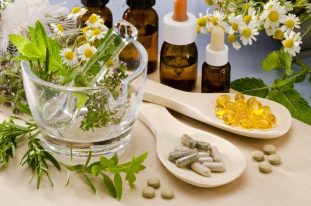Nail fungus – severe skin disease, which is caused by a microscopic one celled fungi are called onychomycosis. Infection with dermatophytes, mold fungi and yeast fungi, representatives usually happens when you visit the public baths and swimming pools, as well as during physical contact with a carrier of the disease.

Fungus of the nail which is better?
The defeat may affect the nail plate and nail rollers in the vicinity of the upper or lower extremities, or have a combined form. The affected nail changes its color becomes yellow, gray or brown. The skin around it is peeling, covered with dark spots. In severe forms under the nail plate can form dense plaque – such a clinical picture characteristic of infection by Candida.
Candida infection
Treatment of any skin diseases, including fungal infections, is a dermatologist. Onychomycosis 1-2 degrees in the initial stage you can get rid of the unpleasant symptoms with the help of recipes of traditional medicine. In the most difficult cases to cure fungus of the nail can only cures the local or a systemic action on the basis of steroid hormones or broad spectrum antibiotics. To use in any way without medical supervision is not recommended, because it is important to first determine which type of fungus and its resistance to certain chemicals.
Medications: which tool to choose?
The choice of a particular drug to get rid of the fungus should be carried out by the attending physician after the serological examination of blood for antibodies to certain types of fungal organisms and microscopy.
In most cases, the patient is assigned to combination regimens, which may include:
- anti-fungal ointments, lacquers and gels;
- medication against fungi systemic activities;
- immunomodulators for activation of the immune (including the local protective functions);
- vitamin and mineral supplements.
Vitamin-mineral complexes are assigned for prevention of deficiency of vitamins and minerals, increase of resistance of organism of different types of infections. New pass in place of the affected nail plate grow strong and healthy, the patient should receive adequate amounts of vitamins E, A, ascorbic acid and phosphorus, calcium, Mani, zinc, chromium and selenium.
Drugs for local action

Remedies in the form of creams, gels, balms, ointments, and lacquers easy to use and possess complex activity. The obvious advantage of such a medium – low absorption of toxic components, which when released in the systemic circulation can cause a severe reaction and has a negative impact on the liver and kidneys. This property allows the use of drugs local action for vulnerable patients, which includes elderly people, patients with severe disorders of the renal and hepatic systems, children, pregnant and lactating women.
Important! Tools for external machining give good therapeutic results only in an early stage of the disease or in mild forms of onychomycosis. In advanced and severe cases, therapy should be supplemented with systemic antibacterial drugs and antifungal action in the form of tablets or capsules.
Preparation-systemic
Almost all of the tablets for internal intake cause toxic damage to the liver, so they should be on prescription, following the recommended dosage. Most often for the treatment of fungus, called dermatophytes, molds and yeast-like fungi are used as medicines.
They all have the same efficiency, but the list of contraindications and side effects each of them may differ, so it is important to consult with a doctor before beginning treatment.
Is it possible to cure fungus people recipes?
In the initial stage of onychomycosis a good effect gives the recipes of alternative medicine that are suitable for patients of any age and do not cause adverse reactions and complications. In severe forms of nail fungus on feet treatment of folk remedies can be used to increase the effectiveness of the therapy.
Disinfectant and antiseptic foot bath
The most popular tool for the destruction of a fungal infection of the feet – soda bath with the addition of iodine. To prepare a healing bath, it is necessary in 5 liters of hot water dissolve 4 tablespoons of sodium carbonate and add 10 drops of iodine (alcohol solution). The temperature of the water should be not less than 42°. Keep your legs in such a bath should be about 15-20 minutes, and after completion of the procedure, lubricate the feet and the nail plate any antifungal cream. Repeat the bath every day in the evening, for 1 month.
Soda solution, you can replace the salt bath. 5-7 liters of water is taken as 200 g of sea salt. You can use the product with natural anti-inflammatory and antiseptic additives: extracts of chamomile, calendula, st. john's wort, thyme. Good job with the nail fungus pine extract, but it should be natural, without added flavors and colors. In the salt bath, you can add a bit of fir or eucalyptus oil, and oils of bergamot and grapefruit (2-4 drops). The duration is 12 minutes. To do a salt bath it is best 2 times a day for 10-14 days.
Tip! The effectiveness of the treatment will be higher if you use a salt with mineral additives: iodine, bromine, magnesium, and calcium.

Decoctions of plants
To stop the processing when fungal diseases can be used decoctions of medicinal plants with antibacterial, anti-inflammatory, antiseptic and wound healing properties. How herbs and plants include:
- lime;
- oak bark;
- sage;
- burdock;
- hives;
- calendula.
These plants also contain large quantities of vitamins, amino acids and mineral components which contribute to the rapid growth of a healthy nail with strong nail plate and to provide an update of the surface layer periungual rollers.
To prepare a decoction, you need 100 g of raw materials (or ingredients), pour a liter of boiling water and simmer for 12-15 minutes. Ready broth drain and allow to cool to a comfortable temperature, and then pour the agent in any deep dish, and immerse the feet for 15 minutes. To make such a mini-bath every day until full recovery.
Oil (esters) of vegetable extracts
Essential oils of eucalyptus, bergamot, tea tree and fir help to achieve excellent results in the treatment of fungal infections of the nails when used regularly. They have antibacterial, antifungal and anti-inflammatory effect and restore the structure of the destroyed fingernails, the acceleration of growth of healthy nail plates.
They must be used according to the following scheme:
- the washing of the feet with warm water and soap;
- treat painful nails from any antiseptic (you can use the "Furatsilin" or "Chlorhexidine");
- moisten a cotton swab with the oil;
- the nails and the skin around them, paying special attention to the affected area.
The procedure should be repeated 3-4 times a day. Duration of treatment – 4 weeks.
Important! Natural essential oils can cause an allergic reaction, which manifests itself with tingling, burning, itching, rash. If you have any of these symptoms of this way of therapy needs to be abandoned.
Treatment with iodine
Alcoholic solution of iodine – a cheap and effective instrument for the treatment of infections of the skin, including fungal infections of the nail. For the use only of the diseased nail it is necessary to put a drop of iodine and gently RUB it into the nail plate and the periungual roller with a cotton swab. Deal with the affected areas need 3 times a day until the end of the treatment. Before the application of iodine to the skin of the feet should be cleaned thoroughly with soap and water and fruit.

Nail fungus: what is better?
To answer this question definitely is not. Traditional medicine safer, as recipes of traditional healers is based on the use of natural ingredients do not penetrate into the blood and no adverse effects on internal organs and their work. In spite of this, to refuse medical treatment this can lead to the development of diseases and infections of healthy tissue.
It is important to understand that all the methods of treatment of onychomycosis at home primarily focused on the removal of the pathological symptoms, but they are not able to cope with the growth and activity of pathogenic flora. Temporary remission of symptoms, does not mean recovery. This clinical picture may indicate the transition of the disease in a latent form, which can deteriorate under the influence of any provoking factor. To avoid this, treat the fungus should be under the supervision of a specialist, observing all his recommendations and appointments.





























